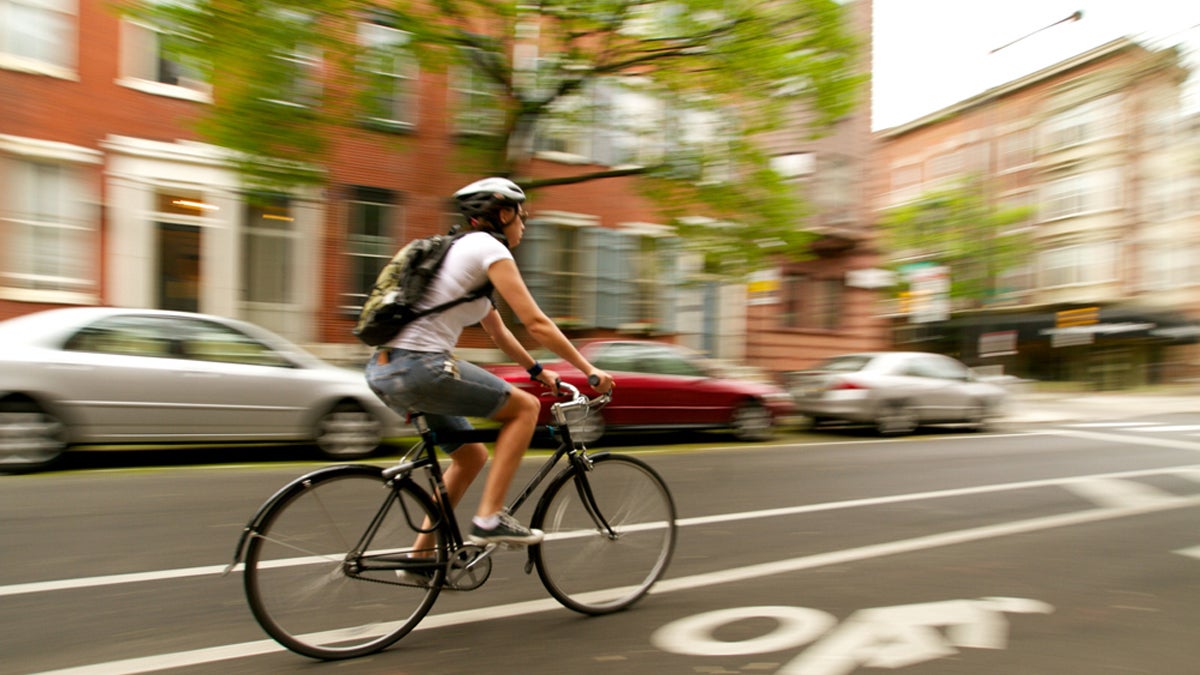Montco approves plan for 800 miles of bike paths
The new master plan approved last week, calls for adding bike lanes in towns, near high schools, colleges, and transit stops, and to connect to park trails.

Montgomery County plans to add 800 miles of bike paths to its on-road bicycle system. (Nathaniel Hamilton for WHYY News, file)
Montgomery County plans to add 800 miles of bike paths to its on-road bicycle system.
The first bicycle plan for the county was adopted in 1998.
“Fast forward 20 years later, and we’ve realized that we haven’t gotten a lot of results out of that plan,” said Matthew Edmond, section chief of transportation for the Montgomery County Planning Commission. “We have about 19.5 miles of bicycle lanes within the county, out of 4,512 miles of roads.
“That’s an extremely low percentage,” Edmond points out — in fact, it’s less than half a percent.
The new master plan called “Bike Montco,” approved last week, calls for adding bike lanes in towns, near high schools, colleges, and transit stops, and to connect to park trails.
Edmond says those focus areas address the main flaw with the old plan, which had a bike lane for all roads.
“[If] every road is planned to have some sort of bike lane on it, [then] pretty much no road gets a bike lane. There was just too much there for really anybody to focus on and work on,” he said.
The project is a big undertaking.
Edmond says the entire process will take decades to complete, but as new bike lanes are created, they’ll be available to riders.
Although the county has capital campaign funds dedicated for projects like this one, Edmond says the overarching idea is to install bike lanes when other things are being improved.

The county plans to start by piggybacking on existing PennDOT improvement projects.
“You’ll have a road that maybe already has a shoulder on it,” Edmond said. “So when they go ahead and they repave it and they re-stripe it, it might be possible to do a bit tweaking with the line striping and put some bike lanes in or some wider shoulders for bike lanes.”
PennDOT’s resurfacing projects in the county cost $70 million a year.
To help decide which roads to focus on, the steering committee used an online tool that measured the level of traffic stress for bicyclists, developed by the Delaware Valley Regional Planning Commission.
“Those are the roads that if you add bicycle lanes to them, you will improve mobility for the greatest number of people. So, that helps to kind of do a little bit of a cost benefit analysis,” Edmond said.
There have been an average of 75 accidents involving bicycles and cars annually in Montgomery County for the past decade, according to PennDOT’s crash data.
Edmond says the project included plenty of public input, including 2,200 surveys collected from weekly visits to the County Courthouse.
“We handed out the survey to people waiting in the jury pool to go through their interviews for jury selection,” he said. “So that had a captive audience, and it got us a lot of people from all throughout the county. It wasn’t just bicycling advocates. We got people from all walks of life, from all places and all levels of interest in bicycling.”
And they used feedback from bike riders and others by creating a Wikimap that allowed the public to suggest where bike paths were needed. Approximately 600 comments were made on an interactive online map.
The county’s 62 municipalities and PennDOT together own nearly 90 percent of the roads within Montgomery County. PennDOT owns 26 percent, while the municipalities own 62 percent.
Funding will come from all levels of government, but the cost is “amorphous,” according to Edmond.
He says it’s impossible to quantify the cost of the planned bicycle network because the price will vary depending on what types of lanes are created and which types of improvements are built, like a protected bike lane or a shared lane.
Edmond also points out that, unlike a city bike program, this is not one-size-fits-all.
Bike Montco’s approach remains flexible, he notes, because there are different roads, different types of communities and different road owners throughout the county.
They plan to produce an annual report to track the changes implemented.
WHYY is your source for fact-based, in-depth journalism and information. As a nonprofit organization, we rely on financial support from readers like you. Please give today.




